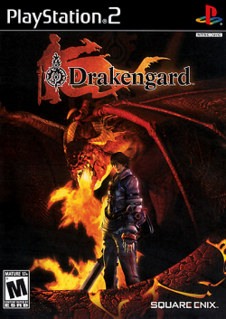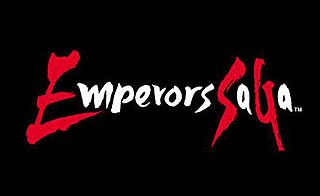
The Final Fantasy Legend, known in Japan as Makai Toushi SaGa, is a video game released for the Game Boy in December 1989 by Square Co. It is the first game in the SaGa series and the first role-playing video game for the system. Square translated the game into English for worldwide release and renamed it, linking it with the Final Fantasy series to improve marketing. Sunsoft re-released it in North America during 1998; Square followed with a Japan-exclusive remake released for the WonderSwan Color and mobile phones in 2002 and 2007 respectively, and later for the Nintendo Switch worldwide in 2020.

SaGa (サガ) is a series of science fantasy open world role-playing video games formerly developed by Square, and is currently owned by Square Enix. The series originated on the Game Boy in 1989 as the creation of Akitoshi Kawazu. It has since continued across multiple platforms, from the Super Nintendo Entertainment System to the PlayStation 2. The series is notable for its emphasis on open world exploration, non-linear branching plots, and occasionally unconventional gameplay. This distinguished the series from most of Square's titles. There are currently ten games in the SaGa series, along with several ports and enhanced remakes.

Final Fantasy Crystal Chronicles is an action role-playing game developed by The Game Designers Studio and published for the GameCube by Nintendo in 2003 in Japan; and 2004 in North America, Europe and Australia. A remastered version for Nintendo Switch, PlayStation 4, Android, and iOS was released in August 2020. A spin-off of the Final Fantasy series and beginning of the series of the same name, Crystal Chronicles was the first title in the franchise to be released for a Nintendo console since Final Fantasy VI in 1994.

Drakengard, known in Japan as Drag-On Dragoon, is a 2003 action role-playing video game developed by Cavia and published by Square Enix for the PlayStation 2. The game is the first installment of the Drakengard series and features a mixture of ground-based hack-and-slash, aerial combat, and role-playing elements which have become a staple of the series. The story is set during a religious war between two factions—the Union and the Empire—with the war tipping in favor of the Empire. The player controls Caim, a deposed prince of the Union, in his quest for vengeance against the Empire. Wounded in battle while protecting his sister Furiae, he is forced to make a pact with a red dragon named Angelus. As they journey together, they join with Hierarch Verdelet on a quest to prevent the Empire from destroying magical seals that keep the world in balance: Furiae acts as the central seal, and her death will drop the world into chaos.

Unlimited Saga is a 2002 role-playing video game developed and published by Square for the PlayStation 2 as the ninth game in the SaGa series. It was released in 2002 in Japan and 2003 in North America and Europe; its European version was published by Atari. The story follows seven characters as they explore mysteries connected to the Seven Wonders, artifacts left by an ancient civilization said to be capable of triggering a golden age. Battles carry over the skill-based levelling systems and nonlinear structure of earlier SaGa titles, with an exploration structure similar to a board game.

SaGa Frontier 2 is a role-playing video game developed by Square for the PlayStation. It is the eighth original game in their SaGa series. Initially released in Japan in April 1999, an English version was made available in North America in January 2000 by Square Electronic Arts and in PAL regions the following March by Square. Development for the title was headed by series creator Akitoshi Kawazu, with music by Masashi Hamauzu. The game features an art style unique to the series at the time it was released, utilizing hand-painted watercolor backdrops and characters to give the game a storybook feel. Like other SaGa games, gameplay is largely non-linear, giving the player multiple paths to follow in order to complete the game.

SaGa Frontier is a role-playing video game developed by Square for the PlayStation and released in Japan on July 11, 1997. The game was later published by Sony Computer Entertainment (SCEA) in North America on March 25, 1998. It is the seventh game in the SaGa series, the first to be released on the PlayStation, and the first to be released under the SaGa brand outside Japan. A remastered version featuring additional characters, events and features is planned for release on April 15, 2021 for Android, iOS, Microsoft Windows, Nintendo Switch and PlayStation 4.

Romancing SaGa is a 1992 role-playing video game developed and published by Square for the Super Famicom. It is the fourth entry in the SaGa series. It was subsequently released for the WonderSwan Color in 2001 and mobile phones in 2009. A remake for the PlayStation 2, subtitled Minstrel Song in Japan, was released in both Japan and North America in 2005 by Square Enix. The storyline follows eight different protagonists on quests through the world of Mardias, all culminating in a fight against the dark god Saruin. Gameplay features nonlinear exploration of the game world, with the turn-based battles featuring group formations. As with other SaGa titles, there are no experience points and character attributes and skills are dependent on actions taken in battle.

Final Fantasy Legend II, known in Japan as SaGa 2: Hihou Densetsu, is a role-playing video game developed and published by Square for the Game Boy. The second entry in the SaGa series, it released in Japan in 1990, and in North America in 1991. A later edition released in North America in 1998 through Sunsoft. The Game Boy version was later ported by Nintendo Switch and released worldwide by Square Enix in 2020. A remake for the Nintendo DS was released in 2009 by Square Enix, remaining exclusive to Japan.

Final Fantasy Legend III, known in Japan as SaGa 3: Jikuu no Hasha, is a role-playing video game developed and published by Square for the Game Boy. The third entry in the SaGa series, it was released in Japan in 1991 and in North America in 1993. A later edition released in North America in 1998 through Sunsoft. A remake for the Nintendo DS was released in 2011 by Square Enix, remaining exclusive to Japan. The Game Boy version was later ported by Nintendo Switch and released worldwide by Square Enix in 2020.

Akitoshi Kawazu is a Japanese game designer, director, producer and writer. After joining Square in 1985, he went on to become a central developer for the first two Final Fantasy titles, then acted as creator and lead developer for the SaGa series.

Romancing SaGa 3 is a 1995 role-playing video game developed and published by Square for the Super Famicom. The sixth entry in the SaGa series, it was also the last developed for the platform. Originally released on the Super Famicom system in Japan on November 11, 1995, the game was released on the Virtual Console in Japan for Wii on September 21, 2010 and Wii U on February 26, 2014.

Romancing SaGa 2 is a 1993 role-playing video game developed and published by Square for the Super Famicom. It is the fifth entry in the SaGa series. It received an expanded port for Japanese mobile devices from Square Enix in 2011. This version was remastered by ArtePiazza and released worldwide between 2016 to 2017 by Square Enix for Nintendo Switch, PlayStation 4, PlayStation Vita, Android, iOS, Microsoft Windows and Xbox One.

Oreimo (俺妹), short for Ore no Imōto ga Konna ni Kawaii Wake ga Nai is a Japanese light novel series written by Tsukasa Fushimi, with illustrations provided by Hiro Kanzaki. The story depicts high school student Kyosuke Kosaka who discovers that his standoffish younger sister Kirino is actually an otaku with an extensive collection of moe anime and younger sister-themed eroge she has been collecting in secret. Kyosuke quickly becomes Kirino's confidant for her secret hobby.

Emperors SaGa is a downloadable social game in the SaGa series from Square Enix. The game was released on the GREE platform on September 18, 2012. In Emperors SaGa, players take the role of the emperor of a nation, and guide the country as its ruler.
Drakengard, known in Japan as Drag-On Dragoon, is a series of action role-playing video games. The eponymous first game in the series was released in 2003 on the PlayStation 2, and has since been followed by a sequel, a prequel, and a spin-off. It was conceived by Takamasa Shiba and Takuya Iwasaki as a gameplay hybrid between Ace Combat and Dynasty Warriors 2. The story was created by Shiba, Iwasaki, Yoko Taro and Sawako Natori, who were influenced by European folklore and popular anime series and movies of the day. Shiba, Yoko, and Sawako have had involvement in every entry of the series since its debut.

SaGa: Scarlet Grace is a role-playing video game co-developed by Square Enix and Studio Reel. The twelfth entry in the SaGa series, the game was published by Square Enix in 2016 for the PlayStation Vita. An expanded port subtitled Ambitions was released in 2018 in Japan and in 2019 worldwide for Android, iOS, Microsoft Windows, Nintendo Switch and PlayStation 4. The story follows four characters pursuing separate missions across the splintered remains of a dissolved Empire; central to the plot is the Firebringer, a rebellious deity defeated during the Empire's height. Gameplay focuses on the protagonists exploring the nonlinear world, taking part in turn-based battles where skill growth depends on chosen actions.

Hiroshi Matsuyama, born in 1970 in Fukuoka, is a Japanese game designer. He is the CEO of the company CyberConnect2. He developed multiple games including the .hack franchise as well as adaptations of the anime series including Naruto and Dragon Ball. Besides developing games, Matsuyama has participated in directing two .hack films as well as voicing a character from the series.
Final Fantasy Crystal Chronicles is a series of video games within the Final Fantasy franchise developed by Square Enix. Beginning in 2003 with the game for the GameCube, the series has predominantly been released on Nintendo gaming hardware and covers multiple genres, including action role-playing. The Crystal Chronicles series takes place on an unnamed world inhabited by four tribes. Recurring themes include creating objects from memory and the importance of family. The gameplay, which has always been aimed at as wide an audience as possible within a genre, generally involves either multiple players or a large group working together.


















